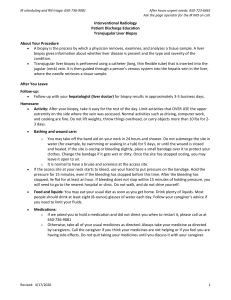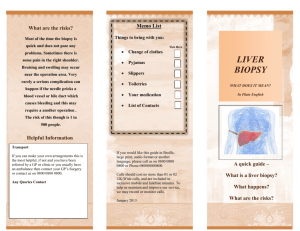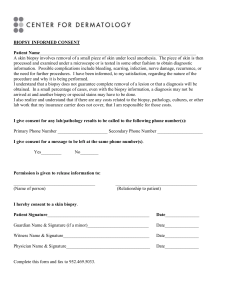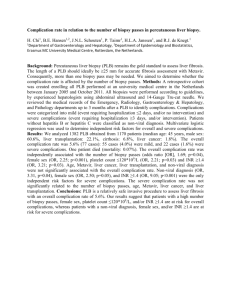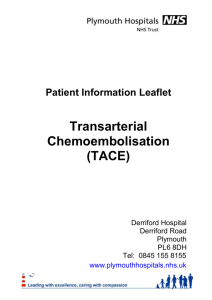Transjugular Liver Biopsy (TJLBx)
advertisement
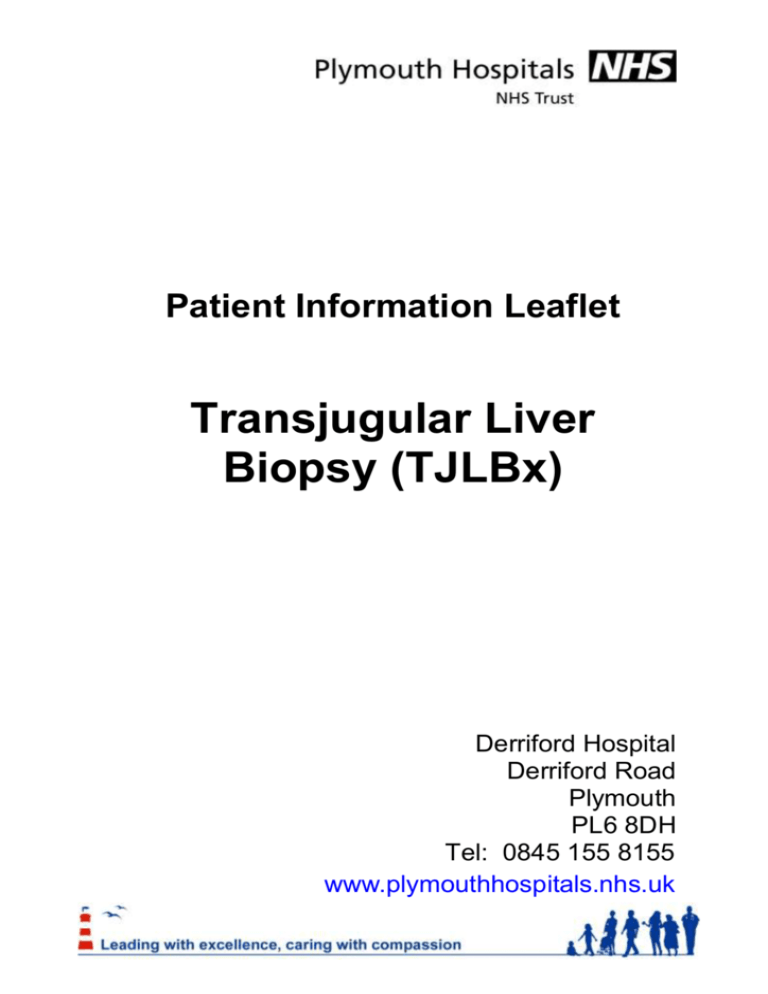
Patient Information Leaflet Transjugular Liver Biopsy (TJLBx) Derriford Hospital Derriford Road Plymouth PL6 8DH Tel: 0845 155 8155 www.plymouthhospitals.nhs.uk This leaflet tells you about having a transjugular liver biopsy. It explains what is involved and what the possible risks are. It is not meant to replace informed discussion between you and your doctor, but can act as a starting point for such discussions. If you have any questions about the procedure please ask the doctor who has referred you or the department which is going to perform it. Referral and consent The referring clinician should have discussed the reasons for this examination with you in the clinic and you should make sure that you understand these before attending. You will be referred to a radiologist for this procedure. Radiologists are doctors who have trained and specialised in imaging and x-ray treatments. Before the procedure you will need to sign a consent form. This form says that you need to know what risks are involved. This is a legal requirement and ensures that you are fully informed about your procedure. If after discussion with your hospital doctor or radiologist you do not want this examination then you can decide against it. If the radiologist feels that your condition has changed or that your symptoms do not indicate such a procedure is necessary then he/she will explain this to you and communicate with the referring clinician. You will return to your referring clinician for review. At all times the radiologist and referring clinician will be acting in your best interests. What is a transjugular liver biopsy? A liver biopsy is a procedure that involves taking a tiny specimen of the liver for examination under a microscope. In most cases, a liver biopsy is taken through the skin by passing a fine needle through into the liver. A transjugular liver biopsy (TJLBx) is an alternative way of obtaining the liver specimen by passing the needle through the vein in the neck (jugular vein). This method is used in patients who have abnormal clotting of the blood or fluid collecting within abdomen. This technique is to reduce the risk of bleeding after the biopsy. Why do you need a transjugular liver biopsy? The doctors looking after you have decided that you need a liver biopsy to obtain more information about your liver problem. The information gained from the biopsy will help the doctors in the treatment of your condition. Are there any risks? Transjugular liver biopsy is a safe procedure, but as with any medical procedure there are some risks and complications that can arise. The overall risk of a problem requiring further treatment is low (1–2%). The main risk is bleeding after the biopsy. However, a TJLBx has a lower risk of bleeding than a conventional liver biopsy taken through the side of the abdomen. Are you required to make any special preparations? A TJLBx is usually carried out as a day case procedure under local anaesthetic. You may be asked not to eat for four hours before the procedure, although you may still drink clear fluids such as water. You may receive a sedative to relieve anxiety, as well as an antibiotic. If your blood clotting is abnormal, you may be given special blood transfusions to try and correct this. If you have any concerns about having blood transfusions, you should discuss these with your doctor. If you have any allergies or have previously had a reaction to the dye (contrast agent), you must tell the radiology staff before you have the test. If you are pregnant of suspect that you may be pregnant you should notify the department. Radiation exposure during pregnancy can lead to birth defects. Who will you see? A specially trained team led by an interventional radiologist within the radiology department. Interventional radiologists have special expertise in reading the images and using imaging to guide catheters and wires to aid diagnosis and treatment. Where will the procedure take place? In the interventional radiology suite which is located within the radiology department. This is similar to an operating theatre into which specialised X-ray equipment has been installed. What happens during a TJLBx? You will be asked to get undressed and put on a hospital gown. A small cannula (thin tube) will be placed into a vein in your arm. The procedure is performed using local anaesthetic and often sedation. The skin at the side of the neck will be swabbed and covered with sterile towels. The skin will be numbed with local anaesthetic. Once the skin is numb, a small tube (catheter) is inserted into the vein at the side of the neck. An X-ray machine is used to guide the catheter into the vein in the liver and then to guide the needle into the liver. Usually, two to three biopsy specimens are taken. Will it hurt? When the local anaesthetic is injected, it will sting for a short while, but this soon wears off. When the catheter is placed in the liver, you may get a dull ache in the right shoulder. This will go away once the tube has been removed. Some people feel a sharp pinch inside the abdomen as the biopsy is taken, but this will only last 1–2 seconds. How long will it take? Every patient's situation is different and it is not always easy to predict how complex or how straightforward the procedure will be. As a guide, expect to be in the X-ray department for about an hour altogether. What happens afterwards? You will be taken back to your ward on a trolley. Nurses on the ward will carry out routine observations, such as taking your pulse and blood pressure, to make sure that there are no problems. You will generally stay in bed for a few hours, until you have recovered. Assuming you are feeling well, you will normally be discharged the same day. 0. Checking your wound site Other Risks A liver biopsy is a very safe procedure but as with any procedure or operation complications are possible. We have included the most common risks and complications in this leaflet. We are all exposed to natural background radiation every day of our lives. This comes from the sun, food we eat, and the ground. Each examination gives a dose on top of this natural background radiation. For information about the effects of X-rays read the publication: “X-rays how safe are they” on the Health Protection Agency website: www.hpa.org.uk Finally Some of your questions should have been answered by this leaflet, but remember that this is only a starting point for discussion about your treatment with the doctors looking after you. Make sure you are satisfied that you have received enough information about the procedure. Contact Interventional Radiology Department 01752 437468/792487 Additional Information Bus services: There are regular bus services to Derriford Hospital. Please contact www.citybus.co.uk www.firstgroup.com www.travelinesw.com Car parking: Hospital car parking is available to all patients and visitors. Spaces are limited so please allow plenty of time to locate a car parking space. A charge is payable. Park & Ride: Buses (number PR3) run from the George Junction Park & Ride Mon-Fri (except Bank Holidays) every 20 mins between the hours of 06:45 and 19:05. The last bus leaves the hospital at 19:14. Patient Transport: For patients unable to use private or public transport please contact TAPS 0845 0539100 Comments and Suggestions We welcome comments and suggestions to help us improve our service. Please fill in a suggestion form or speak to a member of staff. Suggestion forms are located at reception in X-Ray East and West Any Questions If you have any questions please write them here to remind you what to ask when you come for your examination: ___________________________________________ ___________________________________________ ___________________________________________ ___________________________________________ ___________________________________________ ___________________________________________ ___________________________________________ ___________________________________________ ___________________________________________ ___________________________________________ ___________________________________________ ___________________________________________ ___________________________________________ ___________________________________________ ___________________________________________ ___________________________________________ ___________________________________________ ___________________________________________ ___________________________________________ ___________________________________________ ___________________________________________ If you would like this information in another language or format please contact the Interventional Radiology Department 01752 437468/792487 Issue date: October 2014 For review: October 2017 This leaflet has been prepared with reference to the British Society of Interventional Radiology (BSIR) and the Clinical Radiology Patients’ Liason Group (CRPLG) of The Royal College of Radiologists. Legal notice Please remember that this leaflet is intended as general information only. It is not definitive, and the RCR and the BSIR cannot accept any legal liability arising from its use. We aim to make the information as up to date and accurate as possible, but please be warned that it is always subject to change. Please therefore always check specific advice on the procedure or any concerns you may have with your doctor.
